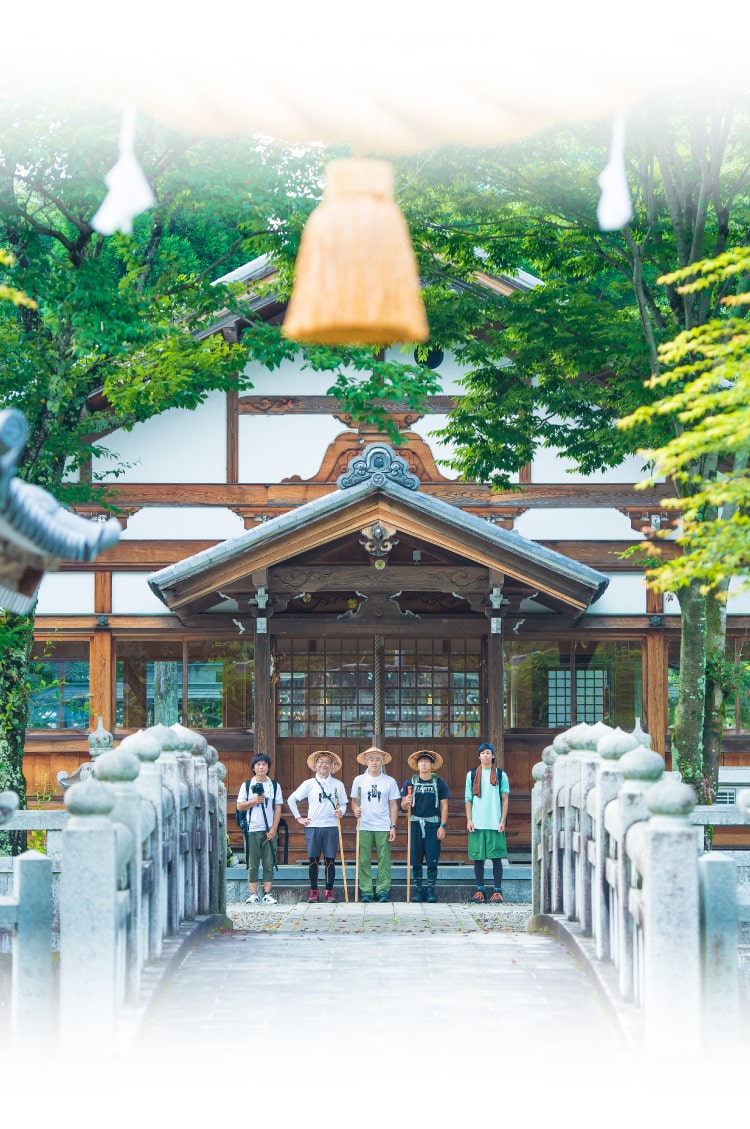Deep inside the mountains of the spiritual mountain, Mt Hakusan.
Nagaragawa River, which the source is from the spring water up on the mountain, is flowing down through the mountains.
Gujo Hachiman, which loves Gujo Odori dance, is one of Japan's three major Bon festival dances, and where you can feel the locality of each area.
Gujo's outdoor activities are based on the idea of Hakusan Faith saying, "Thank nature and cherish mountains and rivers" and developed a series of activities on the mountains, rivers, townscape, and snow.
Go camping, fishing, trekking, rafting, shower climbing, and cycling during the green season. Or go skiing, snowboarding, snowshoes trekking in the snowy world. There are too many activities you can enjoy here.
From outdoor activity beginners to professionals, all people can enjoy so much.
“GO NATURE 365” is a media introducing the deepest part of Gujo, a place to open up yourselves.


Mountain, river, townscape & snow. Filling all 365 days with outdoor activities.
GO NATURE 365






Water from Mt Hakusan crossing Gifu, Fukui, Ishikawa and Toyama joined together and formed Nagaragawa River.
Since ancient times, Mt Hakusan has been worshiped as a mountain of worship, bringing the important "water of life" for farming and living.
It is one of the Three Holy Mountains in Japan along with Mt Fuji and Mt Tateyama with a history of over 1300 years as the head temple of Hakusan Faith spreading throughout Japan. Here, Gujo is one of the bases for Mt Hakusan worship.
During Muromachi era (1336 – 1573), it was so crowded that there is a saying "Thousands of people going up and down, and people’s hats are touching each other."
Why there are so many people worshiped at that time?
The reason is people living at Nobi Plain used the water from the river from the melting snow of Mt Hakusan to produce their crops. Without water, their crops could not grow. So, this made culture appreciate nature and cherish all blessings from the mountains and rivers.
In Hakusan Faith, the mountain itself is a God
In Hakusan Faith, the mountain itself is a God Worship started from Muromachi era, just like trekking in the present day. These outdoor activities were just like normal life for the people living in Gujo. Many local people living among nature wished to share their happiness with others. They developed all outdoor activities little by little and formed the current nature activities.
People in Gujo cherish this history and cultural background.
Since ancient times, Mt Hakusan has been worshiped as a mountain of worship, bringing the important "water of life" for farming and living.
It is one of the Three Holy Mountains in Japan along with Mt Fuji and Mt Tateyama with a history of over 1300 years as the head temple of Hakusan Faith spreading throughout Japan. Here, Gujo is one of the bases for Mt Hakusan worship.
During Muromachi era (1336 – 1573), it was so crowded that there is a saying "Thousands of people going up and down, and people’s hats are touching each other."
Why there are so many people worshiped at that time?
The reason is people living at Nobi Plain used the water from the river from the melting snow of Mt Hakusan to produce their crops. Without water, their crops could not grow. So, this made culture appreciate nature and cherish all blessings from the mountains and rivers.
In Hakusan Faith, the mountain itself is a God
In Hakusan Faith, the mountain itself is a God Worship started from Muromachi era, just like trekking in the present day. These outdoor activities were just like normal life for the people living in Gujo. Many local people living among nature wished to share their happiness with others. They developed all outdoor activities little by little and formed the current nature activities.
People in Gujo cherish this history and cultural background.
Nagaragawa River is one of the three famous clear streams together with Shimantogawa River in Koji and Kakitagawa River in Shizuoka.
Running through north and south of Gujo, passing Mino, Seki, and Gifu cities in Gifu-ken and finally entering Ise Bay.
Over the total length of 166km and over 860,000 people living along the river.
The source of Nagaragawa River is located on Mt Dainichigatake, one of the mountains of the Hakusan mountain range.
The people living in this area, have a strong connection with Nagaragawa River. They pay great afford not to pollute for the people living downstream. People’s lives are largely affected by the river.
They used to say going up or going down the river to express their location. You can know how important the river is to the locals.
Even time passes, water is still the most important element to the farmers. Also during BBQ or a date, people gather and chat by the water making a deep connection. As the “living” river is getting fewer and fewer in Japan, you can still understand people’s thoughts and can still experience on your own here at Gujo.
Running through north and south of Gujo, passing Mino, Seki, and Gifu cities in Gifu-ken and finally entering Ise Bay.
Over the total length of 166km and over 860,000 people living along the river.
The source of Nagaragawa River is located on Mt Dainichigatake, one of the mountains of the Hakusan mountain range.
The people living in this area, have a strong connection with Nagaragawa River. They pay great afford not to pollute for the people living downstream. People’s lives are largely affected by the river.
They used to say going up or going down the river to express their location. You can know how important the river is to the locals.
Even time passes, water is still the most important element to the farmers. Also during BBQ or a date, people gather and chat by the water making a deep connection. As the “living” river is getting fewer and fewer in Japan, you can still understand people’s thoughts and can still experience on your own here at Gujo.
At Gujo, people are not adding nature into their lives, but they are living inside nature.
Fresh green with the contrast of the blue sky.
Golden wheat field swaying in the wind.
Frogs singing with the sunset.
Autumn leaves are dyed in red and orange all over the mountains.
The whole world of silvery white.
Even if you are in the center of the city, Gujo Hachiman, beautiful scenery is just right next to your life.You can see it when you are walking around the city or going cycling. While cherishing the old scenery, Gujo engaged modern technology into daily life.
People from all over the country aiming for Ayu fishing gather at the co-working space for the latest ICT (Information and Communication Technology) on the riverbanks.
There is also a snow slope with the latest equipment in the area where all villagers gather and remove snow from the roof of the shrine.
Tradition, nostalgia, kindness, rigor, newness, and all varieties of people who come and go.
You can enjoy all outdoor activities while experiencing this nice mixture of lifestyles.
That is Gujo, a town of new and old.
Fresh green with the contrast of the blue sky.
Golden wheat field swaying in the wind.
Frogs singing with the sunset.
Autumn leaves are dyed in red and orange all over the mountains.
The whole world of silvery white.
Even if you are in the center of the city, Gujo Hachiman, beautiful scenery is just right next to your life.You can see it when you are walking around the city or going cycling. While cherishing the old scenery, Gujo engaged modern technology into daily life.
People from all over the country aiming for Ayu fishing gather at the co-working space for the latest ICT (Information and Communication Technology) on the riverbanks.
There is also a snow slope with the latest equipment in the area where all villagers gather and remove snow from the roof of the shrine.
Tradition, nostalgia, kindness, rigor, newness, and all varieties of people who come and go.
You can enjoy all outdoor activities while experiencing this nice mixture of lifestyles.
That is Gujo, a town of new and old.
Different areas in Gujo are showing different faces in Winter.
In areas in the north and east, snow sometimes accumulates more than 2 meters high makingthese areas a history of living with a harsh natural environment.
In 1933, the opening of the first ski resort in Gujo led to the birth of more than 10 skiing slopes.
Snow is brought by the north wind blowing from the Sea of Japan from an altitude of over 1,000 m. Thanks to the natural blessings, Gujo has now become a nationally famous winter resort area.
In recent years, as Gujo is easily accessible from Centrair Airport in about two hours, we are planning to welcome tourists who do not go skiing and snowboarding from other Asian countries.
Not only ski resort, the castle town, Gujo Hachiman where you can find good restaurants and nice hotels providing all local experiences, welcomes all visitors for sightseeing.
It is rare among all other ski resorts in the world that you can enjoy both in the same place.
History & culture with ski resort
Enjoy new things right here.
In areas in the north and east, snow sometimes accumulates more than 2 meters high makingthese areas a history of living with a harsh natural environment.
In 1933, the opening of the first ski resort in Gujo led to the birth of more than 10 skiing slopes.
Snow is brought by the north wind blowing from the Sea of Japan from an altitude of over 1,000 m. Thanks to the natural blessings, Gujo has now become a nationally famous winter resort area.
In recent years, as Gujo is easily accessible from Centrair Airport in about two hours, we are planning to welcome tourists who do not go skiing and snowboarding from other Asian countries.
Not only ski resort, the castle town, Gujo Hachiman where you can find good restaurants and nice hotels providing all local experiences, welcomes all visitors for sightseeing.
It is rare among all other ski resorts in the world that you can enjoy both in the same place.
History & culture with ski resort
Enjoy new things right here.



















